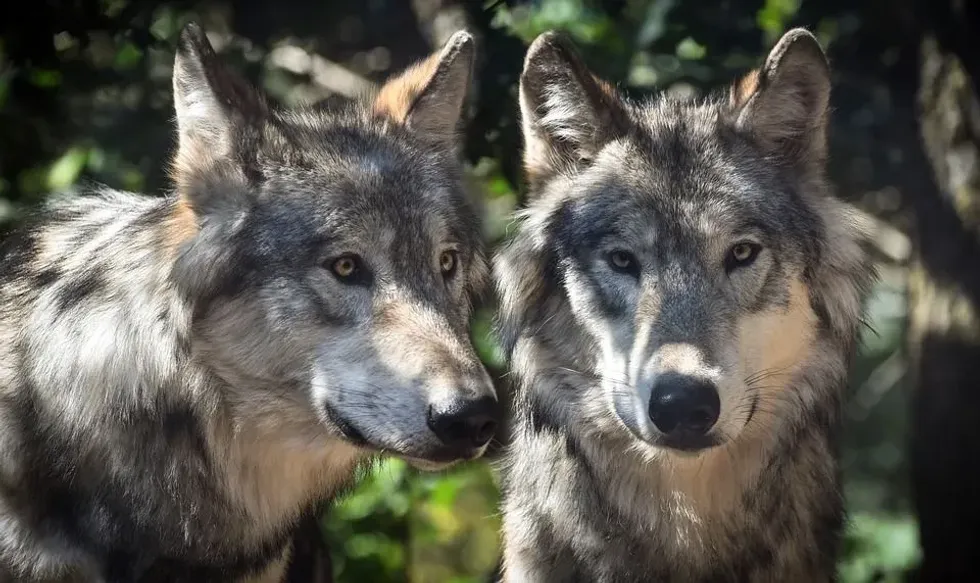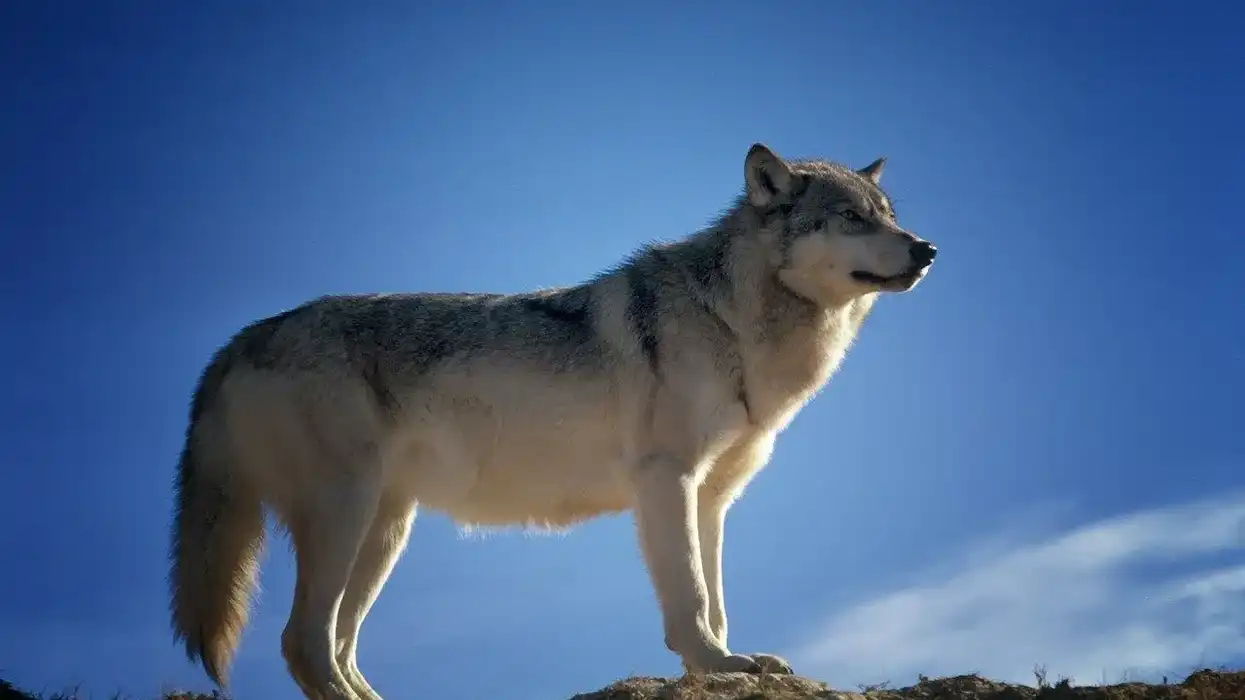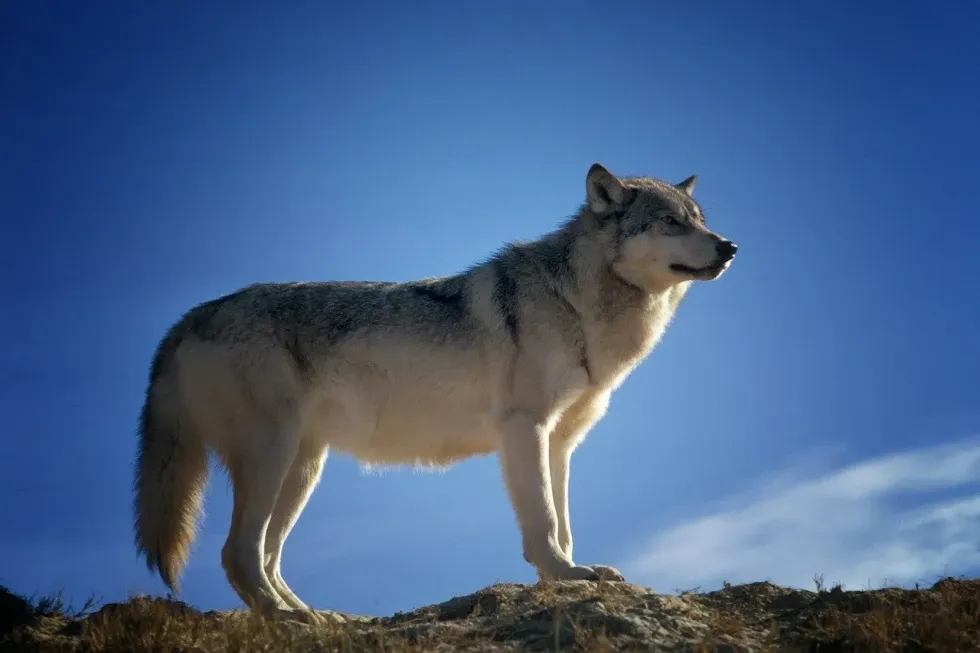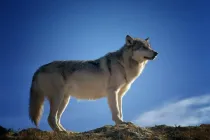Fun Wolf Facts For Kids

Content
- What type of animal is a Wolf?
- What class of animal does a Wolf belong to?
- How many Wolves are there in the world?
- Where does a Wolf live?
- What is Wolf's habitat?
- Who do Wolves live with?
- How long does a Wolf live?
- How do they reproduce?
- What is their conservation status?
- What do Wolves look like?
- How cute are they?
- How do they communicate?
- How big is a Wolf?
- How fast can a Wolf run?
- How much does a Wolf weigh?
- What are their male and female names of the species?
- What would you call a baby Wolf?
- What do they eat?
- Are they slobbery?
- Would they make a good pet?
- Did you know...
- Is a Wolf bigger than a dog?
- How to draw a Wolf?
From the same family as the domestic dog, a Wolf (Canis lupus) is a large canine found in North America and Eurasia. They are also known as Gray Wolves. They can have a length of 104-160 cm (41 - 63 in), and their shoulder height can reach up to 80-85 cm (31-33 in).
These animals have a less pointed muzzle and ears. Their torso is shorter and their tail is longer. These features differentiate them from other Canis.
Being closely related to smaller species of Canis like Golden Jackal and Coyote, they are significantly bigger than dogs. Their fur has a black, gray, or brown color. The subspecies living in the arctic regions can be completely white-colored, though.
Wolves are great hunters, but despite that, they can be hunted by other animals and humans. Some animals eat Wolves like Polar Bears, Grizzly Bears, Siberian Tigers, and other scavengers. Wolves are technically scared of humans.
Although they can attack pets and children, they keep a safe distance away from humans. If you ever face a Wolf, though, there are some points that you should go through. These points may save your life.
The first thing you must do if you have a close encounter with a Wolf is to be calm and make yourself look larger and more intimidating to the Wolf. Maintain eye contact and slowly and steadily back away.
If the Wolf still doesn't run away, continue making yourself look large while still not breaking eye contact or turning your back. If you try to turn and run, they can swiftly outrun, hurt, or even kill you as they're very knowledgeable about their territories.
If you liked reading Gray Wolf facts, you should also read our other articles on pocket pitbull or lab chow mix.
Wolf Interesting Facts
What type of animal is a Wolf?
A Wolf (Canis lupus) is a dog-like animal belonging to the dog family and is a non-domestic member of the family Canidae.
What class of animal does a Wolf belong to?
The Wolf belongs to the class Mammalia as it is a mammal.
How many Wolves are there in the world?
The population of the Gray Wolf is around 200,000-250,000. Wolves were higher in number in Eurasia and North America, but now, they inhabit just a small portion because of the encroachment on and destruction of their habitat.
Where does a Wolf live?
Wolves (Canis lupus) live in Europe, North America, North Africa, and Asia. They prefer to live in the wild, though Red Wolves live in forests, swamps, and coastal prairies. Although it may seem that Wolves like living in colder climates only, they can also live in areas that have temperatures ranging from minus 70 degrees to 120 degrees Fahrenheit.
The Eastern Wolf used to inhabit the northeastern United States, but as of recent times, they only live in southeastern Canada. Eastern Wolves include the Eastern Timberwolves, Great Lakes Wolves, or Deer Wolves.
What is Wolf's habitat?
Wolves like to live in the wild. They can be easily found in the ecosystems like tundra to desert regions and great plains to a temperate rainforest.
This range of climates and habitats have become home to the Wolves and their prey as they have adapted pretty well to them. Presently, Wolves are highly concentrated in the northern regions of the globe like Russia, Canada, and Alaska.
Who do Wolves live with?
Wolves are known for living and moving in packs and marking their territories as they go forward. They have a pack of six to ten members known as a Wolf pack.
They hunt in a pack as well. Wolves can roam far and cover large distances, measuring up to 12 miles in a day. The pack of this animal cooperates to prey on large animals like elk, and deer.
When their prey has been killed, they avoid eating in moderation. A single member of the pack, at a sitting, can easily eat up to 20 pounds of meat.
How long does a Wolf live?
Wolves live around 8-13 years in the wild. But, they are known to survive longer in captivity, which can be up to 15 years.
Some Wolves in the wild can die as soon as they are born; some die or are killed when they are not even fully adult. In captivity, though, they have a better chance of living up to a good and ripe age because they are given regular meals and routine veterinary care.
The major problem faced by these animals is that their pups may not even survive the first winter after they are born. If they do, then their chances of survival rise up to 2-4 more years, and only if they are lucky enough not to have a serious injury and regularly get food.
How do they reproduce?
Wolves mate with the same partner for life, so they are monogamous. If a partner dies, then the remaining Wolf finds another one quickly.
As Wolves don't live for long in the wild, they mature by two years of age.
For their first breeding, environmental factors like the availability of food and if the pack can manage the population, play an important role in their survival. This is so because Wolves can have their young ones at a young age themselves, which can lead to the exploitation of available resources.
Female Wolves can give birth to one pup every year. The Oestrus period for females starts in the second half of the winters. The period is of two weeks, with the gestation period for the animal being 62-75 days.
Pups give birth in the months of spring or early summers in very cold regions. When females are pregnant, they tend to stay in the den within their territory to avoid encounters with other packs.
The dens are constructed in the summers for the pups. They are made from natural shelters like fissures in cliffs and rocks. The play areas for the offspring, resting place, and food are all taken care of when a Wolf den is made.
A young female has a litter of 4-5 pups, whereas older females can have a litter of 6-8 pups. When these pups are born, they come out deaf and blind and look much like German Shepherd dog puppies. Their fur is of soft grayish-brown color.
The weight of puppies is 300-500 g (10.5 – 17.6 oz). Pups start seeing after they are 9-12 days old.
At the age of 3-4 weeks, they start eating solid food. The first four months the young Wolves have a fast growth rate increasing their weight 30 times. By the autumn season, the young Wolves are mature enough to accompany adult Wolves for hunting and protecting their territory.
What is their conservation status?
The IUCN has classified this animal as Least Concern. In 2003, the population of wild Wolves around the globe was around 300,000. Despite the threats faced by the Wolves like habitat destruction, competition, and more, they have a good population count.
Wolf Fun Facts
What do Wolves look like?

Gray Wolves, as they belong to the Canidae family, look like dogs. They have bushy tails, and their coat color has a mix of brown and gray. Wolves look like a large German Shepherd dog. You can call this animal a maned wolf.
How cute are they?
Wolf pups are very adorable, like dog puppies. They look very cute because of the innocence that they have on their faces. As they grow old, their innocence is lost to some extent. But as they share the same family as dogs, their features, characteristics, and behavior sometimes make them very adorable like dogs.
How do they communicate?
The most famous thing you would have heard about Wolf communication is their howling. Wolves howl at any time, but mostly, they howl in the evening as that is their most active time. The vocalized communication of Wolves can be easily divided into four types: howling, barking, growling, and whimpering.
Wolves bark to warn so it is wise to pay heed to the barks of a Wolf. Mother Wolves may bark to warn their pups if she feels there is danger around.
Barking can also be used for displaying aggressive behavior while defending their packs. Whimpering is a form of communication where mothers tell their young ones that she is willing to nurse them. It can also be used as the signal for giving up if a submissive Wolf, who is whimpering, is facing a dominant Wolf.
Growling is used for warning and to scare off predators or to attack Wolves from their territory. Howling, the most famous kind of Wolfish communication, is used for longer distances.
Other than the vocalizations, Wolves have their body language as well. In anger, their teeth are bare, and their ears are straight up. When they are suspicious, they squint and pull their ears back. A playful Wolf will dance and bow.
How big is a Wolf?
The most common type of Wolves, the Gray Wolves, can have lengths of 4-6.5 feet (120-200 cm) and weigh up to 18-79 kg (40-175 lb). They are bigger when compared to Red Wolves who grow up to 4.5-5.5 feet (137-168 cm) in length and weigh around 23-36 kg (50-80 lb).
How fast can a Wolf run?
Wolves can run pretty fast at a speed of 50-60 kph. As dogs are good at running, belonging to the same family, Wolves are good at running too. Also, they have to hunt deers, and hence, their running speed has evolved enough to hunt for food and survive.
How much does a Wolf weigh?
Depending on their location, the weight of Wolves can differ. The smallest Wolf, the Arabian Wolf, is known to have 30 pounds of weight and live in the southern Middle East.
The adult male Gray Wolf living in northern Minnesota can weigh around 70 - 110 lb, and adult females can weigh between 50 - 85 lb. Gray Wolves that belong to Canada, northwestern United States, Alaska, and Russia are larger, and the males from these regions can weigh up to 85-110 pounds.
They can also reach 130 pounds, occasionally. Females are known to weigh about 20 percent lesser than males.
What are their male and female names of the species?
There is no given name for the Wolf species' male and female counterparts, but females are called she-wolf or bitch, whereas the males are called dog or Wolf.
What would you call a baby Wolf?
Baby Wolves are known as pups. In a pack, usually, the leader and his mate are the only ones who give birth to young ones.
After mating in the late winter and nine weeks of the gestation period, females give birth to 1-11 pups. The pups are cared for by the adult Wolves of the pack.
At around 5-10 weeks of age, they start having solid food. At the age of six months, pups are ready to hunt, and by the time they are two years old, they become adults.
What do they eat?
Wolves are carnivores and eat up to 9 kg (20 lb) of food at one time. They only eat meat that they hunt. Gray Wolves are known to hunt big animals like goats, deer, moose, and elks. Wolves attack their prey in a pack and can hunt wild or domestic animals.
Are they slobbery?
Yes! They have been observed to be slobbery like our domestic dogs. However, they do not salivate as dogs do. They have the same tongue as dogs, and they also groom themselves like dogs with their tongues.
Would they make a good pet?
Some people do keep Wolves as exotic pets. They do not make a good pet, though, because they do not respond to human commands. They, instead, tend to act aggressively. Even if you end up petting a Wolf, they can maul you fatally, even if they are only playing. So, it is advised not to keep a pet Wolf.
Did you know...
Here are some facts about Wolves that you might not be aware of. You can tell these facts to your kids for fun.
A Wolf packs travel up to 20 km (12 miles) a day.
Wolf saliva has antiseptic properties. Its saliva can help in wound healing.
The largest wild canine species is the Gray Wolf.
Wolves howl to create a stronger bond and also to warn other packs to stay away. Another way of communication used by Wolves is by leaving scent-marking through feces or urine on a trail.
Is a Wolf bigger than a dog?
Yes, Wolves are bigger than dogs. They are longer and taller than the majority of the dogs. The fur of Wolves helps them to look bigger.
How to draw a Wolf?
It is super easy to draw a Wolf. If you want to teach a kid how to draw a Wolf, the following steps will make the drawing process super easy and fun.
Start with drawing a bean-shaped body. On this body, you have to add a nose and a mouth.
After the nose and the mouth of the Wolf are ready, draw the eyes and ears. Make sure to keep the eyes close to the nose. On the bean-shaped body, draw two front legs and paws.
Now, in the same way, draw two hind legs on the end side of the bean-shaped body. The important detail to add is the tail. Draw the tail. As a Wolf is fuzzy, draw the fuzzy hairlines on the head, face, and chest of the drawn Wolf.
After your drawing is complete, outline it with dark color and fill the gray color in your Wolf to give it a good touch.
Here at Kidadl, we have carefully created lots of interesting family-friendly animal facts for everyone to discover! Learn more about some other mammals including Pitbull Chihuahua mix, or Cheagle.
You can even occupy yourself at home by drawing one on our Sleeping Wolf coloring pages.
We Want Your Photos!
More for You
Sources
https://kids.nationalgeographic.com/animals/mammals/facts/gray-wolf
https://en.wikipedia.org/wiki/Wolf
https://www.britannica.com/animal/wolf
https://kids.nationalgeographic.com/animals/mammals/facts/gray-wolf
https://a-z-animals.com/animals/wolf/
https://www.nwf.org/Educational-Resources/Wildlife-Guide/Mammals/Gray-Wolf
See All
Bachelor of Commerce specializing in Accounting and Finance, Master of Business Administration

Divya RaghavBachelor of Commerce specializing in Accounting and Finance, Master of Business Administration
With a diverse range of experience in finance, administration, and operations, Divya is a diligent worker known for her attention to detail. Born and raised in Bangalore, she completed her Bachelor's in Commerce from Christ University and is now pursuing an MBA at Narsee Monjee Institute of Management Studies, Bangalore. Along with her professional pursuits, Divya has a passion for baking, dancing, and writing content. She is also an avid animal lover who dedicates her time to volunteering for animal welfare causes.
Bachelor of Arts specializing in English Literature

Deeti GuptaBachelor of Arts specializing in English Literature
A detail-oriented fact-checker with a research-oriented approach. Devika has a passion for creative writing, she has been published on multiple digital publishing platforms and editorials before joining the Kidadl team. Currently pursuing a Bachelor of Arts in English Literature from St.Xavier's College, Deeti has won several accolades and writing competitions throughout her academic career.
Disclaimer
1) Kidadl is independent and to make our service free to you the reader we are supported by advertising. We hope you love our recommendations for products and services! What we suggest is selected independently by the Kidadl team. If you purchase using the Buy Now button we may earn a small commission. This does not influence our choices. Prices are correct and items are available at the time the article was published but we cannot guarantee that on the time of reading. Please note that Kidadl is a participant in the Amazon Services LLC Associates Program, an affiliate advertising program designed to provide a means for sites to earn advertising fees by advertising and linking to Amazon. We also link to other websites, but are not responsible for their content.
2) At Kidadl, we strive to recommend the very best activities and events. We will always aim to give you accurate information at the date of publication - however, information does change, so it’s important you do your own research, double-check and make the decision that is right for your family. We recognise that not all activities and ideas are appropriate for all children and families or in all circumstances. Our recommended activities are based on age but these are a guide. We recommend that these ideas are used as inspiration, that ideas are undertaken with appropriate adult supervision, and that each adult uses their own discretion and knowledge of their children to consider the safety and suitability. Kidadl cannot accept liability for the execution of these ideas, and parental supervision is advised at all times, as safety is paramount. Anyone using the information provided by Kidadl does so at their own risk and we can not accept liability if things go wrong.
3) Because we are an educational resource, we have quotes and facts about a range of historical and modern figures. We do not endorse the actions of or rhetoric of all the people included in these collections, but we think they are important for growing minds to learn about under the guidance of parents or guardians.







